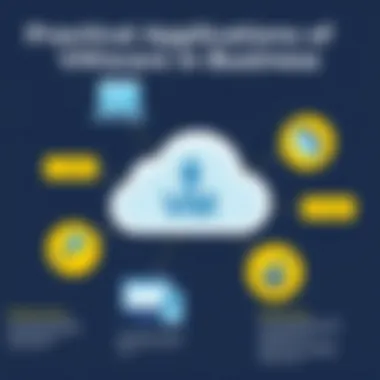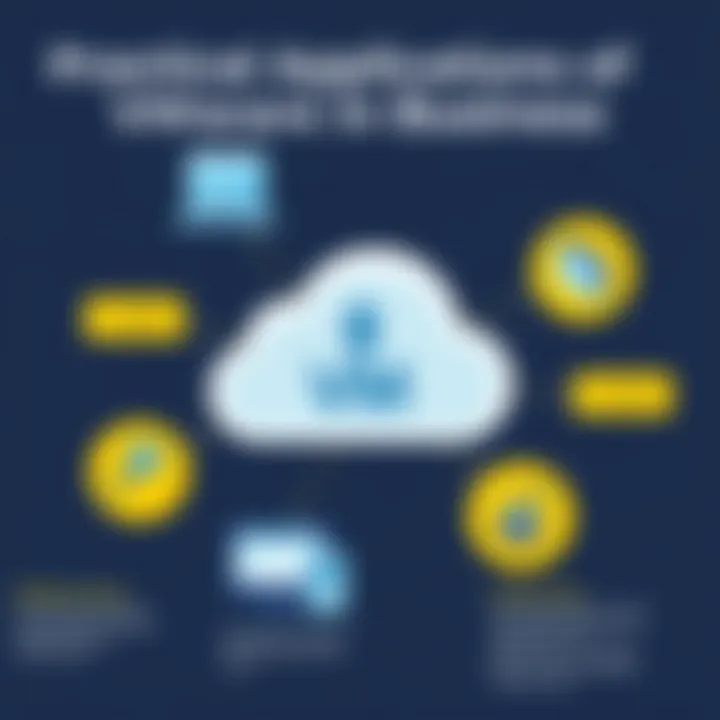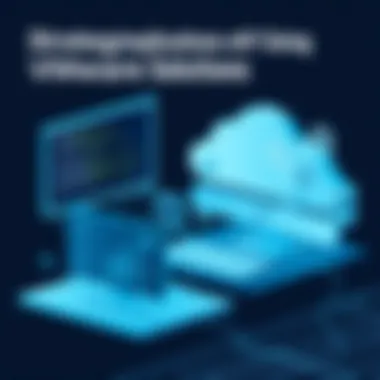Understanding the VMware Free Trial: Benefits and Uses


Intro
Navigating the landscape of virtualization software can be a daunting task, especially for those who are not deeply entrenched in the technical nuances of the field. As organizations and individuals look to optimize server performance and maximize resource utilization, VMware has positioned itself as a leading figure in this arena. The VMware free trial offers a gateway for potential users to explore these powerful solutions without financial commitment.
In this article, we will unpack the VMware free trial, highlighting its features, registration process, and how users can tap into its full potential. Additionally, we will explore some real-world applications, considerations for different user groups, and the implications of adopting VMware's technology in today's fast-paced business environment. Understanding this offering means not only assessing its advantages but also recognizing its limitations. Let's delve deep into this landscape to give you clarity and actionable insights.
Prologue to VMware Free Trial
In the fast-paced world of technology, understanding the tools at our disposal can be a game changer. The VMware free trial is not just a promotional gimmick; it embodies a robust opportunity for individuals and businesses alike to engage deeply with virtualization technology. By allowing potential users to explore VMware's diverse offerings without financial commitment, it opens the door to innovative solutions that could transform operations. As virtualization grows in significance across industries, diving into the capabilities of VMware becomes even more pertinent.
With the free trial, users can experiment with an array of products that facilitate better resource management, improved scalability, and enhanced security. The trial serves as a gateway for businesses to assess the fit of these solutions within their existing infrastructure before making any financial investments. Understanding this initiative is crucial, especially as the landscape of IT continues to evolve.
Key aspects of the VMware free trial include:
- Hands-on Experience: This initiative offers users a direct experience with the software, enabling them to evaluate its functionalities in real scenarios.
- Reduced Risk: With no upfront costs, businesses can gauge the value without the pressure of a financial commitment.
- Informed Decision Making: Engaging with VMware products allows for a clearer understanding of how they integrate with current systems, aiding in strategic planning.
In the realm of virtualization, experimentation may very well lead to unexpected innovations, thus making the VMware free trial a worthy consideration for anyone looking to navigate this terrain.
This article explores these elements, dissecting the purpose, benefits, and considerations surrounding VMware's free trial initiative, ensuring readers are well-equipped to capitalize on the experience.
Registration Process for VMware Free Trial
Understanding how to sign up for the VMware free trial is fundamental for anyone looking to delve into the world of virtualization. The registration process is your gateway to experiencing the functionality that VMware has to offer, allowing potential users to assess the performance and benefits of their products without any upfront commitment. Emphasizing an easy sign-up allows users to explore VMware's capabilities effectively, highlighting the importance of this section.
Prerequisites for Registration
Before diving headfirst into the registration process, it’s crucial to ensure you have the necessary prerequisites. The following points outline what you should have at your fingertips:
- Email Address: A valid email is essential as it's the primary communication channel for VMware. Ensure it's one you check frequently.
- Internet Connection: Since the registration and the subsequent trial usage require online access, a stable internet connection is non-negotiable.
- Basic Understanding of Virtualization: While you don’t need to be an expert, having some foundational knowledge about virtualization concepts can make your journey smoother.
- Compatible Hardware: Check that your computer meets the minimum specifications required by the VMware product you intend to trial. This information can typically be found on VMware’s website.
By checking off these prerequisites, you’ll pave the way for a hassle-free registration experience.
Step-by-Step Registration Guide
Navigating the registration process can feel daunting, but with a straightforward approach, it can be as smooth as butter. Here’s a step-by-step guide to walk you through:
- Visit VMware's Homepage: Start by going to VMware’s official site.
- Locate the Free Trial Section: Look for the section dedicated to free trials. Typically, this will be prominently displayed on their homepage.
- Choose Your Product: Select the specific product you want to trial. VMware offers a variety of products, each tailored for different needs.
- Click on ‘Start Free Trial’: After selecting a product, you will find an option to start the free trial. Click this to proceed.
- Fill Out the Registration Form: Enter the required information. Apart from your email, details like your name, company (if applicable), and sometimes phone number may be requested.
- Accept Terms and Conditions: Carefully read through the end-user license agreement and other terms. Check the box to agree to them before proceeding.
- Confirm Your Email: After submitting the form, check your email for a confirmation message from VMware. Click the verification link to validate your email address.
- Set Up Your Account: Once verified, follow the prompts to create your account password and finalize the registration.
- Download and Install the Software: After setting up your account, you’ll gain access to software downloads specific to the product you’re interested in. Follow the installation instructions provided on the site.
- Begin Your Trial: After installation, log in using your newly created account credentials to start test-driving VMware's solutions.
Completing these steps will set you on the path to exploring VMware’s extensive offerings, preparing you for a hands-on experience that can significantly enhance your knowledge of virtualization.
Features of the VMware Free Trial
Exploring the features of the VMware Free Trial is crucial, as this is where users can truly understand what they’re getting into. It highlights the specific products at their fingertips, as well as the limitations that come along with the trial experience. Having this info is like holding a map before venturing into unknown terrain—it informs expectations and helps users strategize how best to utilize the free resources.
Products Available for Trial
VMware offers a variety of products under the free trial program, catering to different needs—whether in a business setting or for individual users. Some prominently featured products in the trial include:
- VMware vSphere: This is the backbone of VMware’s virtualization solutions, allowing for efficient management of multiple virtual machines on a single server.
- VMware Horizon: Perfect for users looking to deploy virtual desktops, Horizon enables seamless access to desktops from anywhere.
- VMware Workspace ONE: This integrates various tools for managing employee access and securing data across devices—a boon for any IT professional looking to maintain control.
- VMware Cloud Foundation: This offers a comprehensive solution for managing both virtual and physical workloads through a unified platform.
Each of these products serves a unique purpose, enabling users to get hands-on experience, albeit with constraints that could impact functionality.
Trial Duration and Limitations
Understanding the duration and limitations of the VMware Free Trial is key to maximizing its benefits. Typically, the trial lasts for 30 days, which may feel like a short span, but it’s often adequate for assessing various features and performance. Here’s what you should bear in mind:


- Limited Access: Some functionalities might be restricted during the trial period. For instance, advanced features may only be available to paying users, meaning users may not get the full flavor until they commit financially.
- Support Limitations: While support is often available, it might not be as comprehensive as what paying customers receive. In many cases, community-driven resources like forums and FAQs become invaluable for troubleshooting.
- Usage Caps: Users should also be aware of any restrictions on usage levels, such as the number of virtual machines or server resources allocated.
Keeping these limitations in mind allows users to strategize effectively—focusing on testing the vital features they would require from the software in a production environment.
"The key to getting the most out of a free trial lies in preparation and focus. Knowing what tools you need to assess makes all the difference."
By steering through these features and constraints wisely, users can better gauge whether VMware's offerings align with their unique needs.
Maximizing the Free Trial Experience
Maximizing the Free Trial Experience is a crucial element when using VMware's offerings. It is not just about accessing a product temporarily; it’s about leveraging that access to unlock the full potential of VMware’s tools. The free trial provides users, especially businesses and IT professionals, with an opportunity to explore the capabilities of software that could enhance productivity and streamline operations. Getting the most out of this trial can shape future decisions on whether to invest in a long-term solution.
Understanding the ins and outs of the trial can help users to identify specific features that align with their needs. With careful planning and strategic use during the trial period, these individuals can make a well-informed choice about moving forward with VMware products. This not only saves money but also ensures that the selected software will indeed meet the company's or individual’s needs effectively.
Best Practices for Usage
To effectively utilize the VMware Free Trial, adhering to some best practices can make a significant difference:
- Set Clear Objectives: Before diving in, outline what you aim to achieve during the trial. Are you testing functionality for specific tasks, or are you evaluating overall performance? This clarity can guide your exploration.
- Involve Key Stakeholders: If applicable, include relevant team members in the testing process. Their insights may provide valuable feedback and highlight additional needs or requirements.
- Explore Comprehensive Features: Don’t just scratch the surface. Delve deep into different functionalities—networking options, performance monitoring, or integration capabilities. This exploration can reveal how various aspects work together in a cohesive manner.
- Regular Feedback Loops: Create a system for collecting and discussing observations from users throughout the trial. This could be in the form of weekly meetings or shared documents where experiences are logged.
- Prepare for Future Integration: As you assess the trial, consider how VMware's offerings could mesh with your current systems. Think about migration strategies or potential adjustments that may be necessary.
Applying these best practices will ensure that users aren't just functioning on autopilot during the trial but are intentionally exploring and assessing the software.
Common Pitfalls to Avoid
Even with the best intentions, several common pitfalls can derail a fruitful VMware Free Trial experience. Recognizing these will help tailor the usage effectively:
- Ignoring Documentation: Many users skip over the wealth of documentation and tutorials available. However, these resources are vital to understanding nuanced features and improving usability. Find them on the official VMware documentation site.
- Overlooking Community Forums: Engaging with community forums like Reddit can provide practical insights and solutions to common challenges faced by users. The shared experiences of others can pave the way to overcoming hurdles.
- Failure to Test Real Scenarios: It's common for users to experiment with basic functionalities but fail to apply these features in real-world scenarios. Try to simulate actual business challenges to see how VMware can address them.
- Neglecting System Requirements: Sometimes, users do not check if their existing infrastructure meets VMware's requirements. Testing on incompatible systems might lead to frustrating experiences or inaccurate performance evaluations.
- Shortening the Evaluation Period: It's easy to underestimate the need for sufficient time to evaluate software. Rushing through can result in overlooking essential aspects that may not be evident in the early stages.
Being aware of these pitfalls and actively avoiding them allows users to have a smoother experience with the VMware Free Trial, thus ensuring an enriched understanding of its offerings.
"A trial period without clear objectives is like shooting arrows in the dark. You may hit a target, but most likely, you won't."
Support and Resources During the Trial
Navigating a new software environment can be quite the wild ride, especially if you’re diving into VMware for the first time. The robust support system and resources available during the trial period are pivotal. This segment sheds light on why these elements matter and how they can dramatically alter the trial experience. Whether you’re a seasoned IT pro or a newcomer, having the right backup can transform potential hurdles into mere speed bumps.
Accessing Customer Support
When you're in the trenches with a new platform, the last thing you want is to feel like you're shouting into the void. VMware understands this, and that's why access to customer support is paramount during your trial. Users can find assistance through several channels, which include:
- Phone Support: Direct access to VMware's knowledgeable representatives can provide immediate help for pressing issues. Just a call can clear up confusion that might halt your workflow.
- Live Chat: For those who prefer typing out their queries, the live chat feature on their site allows for unhurried conversations with support agents.
- Support Forums: Engaging with the community can offer insights not just from VMware's team, but from fellow users who might have faced similar challenges.
It's worthwhile to mention that the level of support you receive may vary, but generally, users express that having multiple avenues to seek help greatly enhances their confidence while using the software. This builds a sense of community and shared learning, often resulting in faster problem resolution.
Leveraging Documentation and Tutorials
Another key aspect of maximizing your VMware trial are the extensive documentation and tutorials provided by VMware. These aren't your run-of-the-mill, dry manuals. Think of them more as a treasure map—if you know how to read them, you can locate valuable information that might otherwise take forever to dig up. Here’s how you can make the most of these resources:
- Getting Started Guides: These guides are your best friend if you’re just dipping your toes into the software. They outline the initial steps, ensuring that you can hit the ground running.
- Video Tutorials: Visual learners can benefit from a range of video materials. These allow you to follow along as someone demonstrates the features in real-time, making it easier to grasp complex functionalities.
- Knowledge Base Articles: Need specifics? The knowledge base is loaded with in-depth articles addressing common questions and technical scenarios. Here you’ll find everything from installation procedures to troubleshooting tips.
Utilizing these resources effectively can significantly improve your understanding and usage of VMware products. > "The right information at the right time can often be the difference between success and frustration."
In sum, while the technology is powerful, knowing where to turn when you’re stuck is equally crucial. The synergy of good customer support and accessible resources creates a cushion that can help users navigate their trial without feeling overwhelmed.
Evaluating VMware Solutions Post-Trial


After experiencing the VMware free trial, assessing its strengths and potential weaknesses becomes essential. This evaluation not only guides you in selecting the right tools but also reflects on how effectively the chosen solution aligns with your operational needs. One must consider various elements that play a pivotal role in determining whether to transition from a trial to a permanent setup.
Here's what to look for while evaluating VMware solutions:
- Relevance to Business Needs: Are the features offered in the trial resonating with your specific use case? Pinpointing relevant applications is key. Are you looking for better virtualization, improved security, or seamless scalability?
- Return on Investment: Can you quantify the value gained during the trial? Take stock of time saved, productivity enhancement, or indeed financial implications!
- Integration Capabilities: How well does VMware fit into your existing infrastructure? It’s vital to consider compatibility with current systems and software already in use.
The ability to measure a solution's impact on your operations provides clarity about its significance for future investments.
Evaluating following these factors fosters a clearer understanding of performance and usability in practice.
Assessing Performance and Usability
When you dive into performance assessments, it’s about more than just superficial metrics. Beyond mere system speed and responsiveness, you should venture into several factors:
- System Stability: Did you experience crashes or glitches? Reliable software minimizes downtime.
- User Interface: Was navigating through the platform intuitive? A convoluted interface can hinder productivity, irrespective of the underlying software's capabilities.
- Capacity and Scalable Solutions: Consider how well the application managed tasks under various loads. As workloads change, scale should not lead to fragmentation in performance.
By providing detailed feedback on these parameters, one can effectively gauge overall usability. Memory management and load distribution often highlight areas requiring improvement or, conversely, validation of robust performance claims.
Comparative Analysis with Alternatives
Taking a comparative lens, evaluating VMware in relation to competitors can consolidate the decision process. Here are factors to ponder when stacking VMware against other choices:
- Feature Set: What unique offerings does VMware bring to the table? While other platforms might have similar core features, diving deep into specifics can reveal differentiators.
- Pricing Structure: When looking at the financial aspect, ensure you're comparing like-for-like. Hidden fees and varying licensing agreements can skew perceived value. Evaluate long-term cost benefits against immediate needs.
- Market Position and Reputation: Understand where VMware stands in the industry. Engaging with user experiences via forums like reddit.com or reviewing extensive ratings can provide insights into reliability.
Highlighting these aspects supports making a well-informed decision, ensuring that whether you opt for VMware or an alternative, it’s one that fits seamlessly into your operational narrative.
In the end, a nuanced evaluation will not only sharpen your understanding of VMware's offerings but also empower you to move forward with an informed decision on whether to incorporate it into your toolkit.
Use Cases for VMware Solutions
In the competitive landscape of technology solutions, VMware stands out not just for its products but for the practical applications they support across various fields. The importance of showcasing use cases for VMware Solutions in this article cannot be overstated. Understanding specific scenarios in which VMware's offerings excel can significantly aid businesses and individuals in leveraging these tools effectively. These use cases highlight not only the versatility of VMware products but also their capacity to solve complex problems, streamline operations, and enhance efficiency.
Applications in Business Environments
In business settings, VMware's solutions are pivotal for enhancing IT infrastructure and facilitating seamless operations. From infrastructure virtualization to cloud computing, businesses can harness VMware's capabilities to adapt to the ever-evolving technological landscape. Here are several notable applications:
- Virtual Desktop Infrastructure (VDI): Many companies utilize VMware Horizons for remote desktop solutions. It allows employees to access a virtual workplace from anywhere, providing flexibility and aiding in disaster recovery.
- Data Center Consolidation: Businesses can streamline their operations by consolidating servers using VMware's virtualization technologies. This saves on physical space and lowers hardware costs, ultimately enhancing power efficiency.
- Disaster Recovery Solutions: VMware offers robust disaster recovery plans that help businesses maintain continuity. Solutions like VMware Site Recovery Manager simplify the complexities of backup systems and ensure quick recovery in case of data loss or system failure.
- Cloud Migration: Enterprises are often tasked with moving data to the cloud while minimizing downtime. VMware’s cloud solutions facilitate an easier transition and assist in maintaining security throughout the process.
Analyzing these applications underlines the crucial role VMware can play in driving efficiency and innovation in contemporary business environments.
Educational and Personal Use Cases
VMware's offerings aren't limited solely to large enterprises; educational institutions and individual users also find immense value in utilizing VMware Technologies. Here, the flexibility and comprehensive features of VMware solutions provide unique benefits:
- Educational Institutions and Learning Labs: Many universities incorporate VMware into their IT education programs. Virtual labs allow students to practice in secure environments without the need for extensive physical hardware, exposing them to real-world skills.
- Testing and Development: For software developers, creating virtual machines with VMware simplifies the process of testing applications across different systems. This can significantly accelerate development cycles by allowing debugging and experimentation without risk to the primary system.
- Personal Projects and Experimentation: Hobbyists or tech enthusiasts often use VMware Workstation to create isolated environments for experimentation. This includes testing new software or learning networking capabilities without impacting their primary operating systems.
By delving into these diverse applications, we can see that VMware not only provides solutions that cater to businesses but also supports educational and personal growth initiatives, making their solutions integral across multiple domains.
The multifaceted nature of VMware applications highlights its adaptability and effectiveness. Whether in a corporate boardroom or a university classroom, VMware has become a key player in today's digital environment.
Considerations Before Committing to Purchase
Before diving into the world of VMware’s solutions, it’s essential to take a step back and consider the implications of committing to a purchase. The VMware free trial is an excellent way to explore the capabilities of their products, but understanding the broader context around licensing and financial commitments can make a considerable difference in decision-making.
Understanding the Licensing Structure


When contemplating a purchase, comprehending the licensing structure offered by VMware is crucial. Licensing is like the roadmap that guides you through using VMware products. It indicates not just how many devices can access a particular service, but also any restrictions or obligations that come along with usage.
VMware provides a range of licensing options—perpetual licenses, subscription models, and even enterprise agreements. The perpetual license typically allows one-time payment for indefinite use, while subscription models are renewals that can fluctuate in price based on usage levels. This can affect budgeting significantly and requires evaluation against your business’s operational model.
Moreover, it’s important to note the difference in features that come with various licensing tiers. For instance, some basic licenses may limit certain functionalities that higher tiers include. Choosing the wrong tier can lead to a nightmare of unmet expectations. Therefore, thoroughly understanding the licensing tiers aids in aligning your capabilities with your needs. Here is a brief overview of common licensing structures:
- Perpetual License: One-time purchase with no ongoing fees.
- Subscription License: Regular payments that grant continued access, often tied to additional updates.
- Enterprise License Agreement: A tailored agreement meant for larger organizations, often at a discount for bulk use.
Financial Implications of Long-Term Usage
The financial implications of committing to VMware solutions can look daunting at first glance, yet taking a closer look allows for a clearer picture. Beyond the initial costs of purchasing a license, it’s important to consider the costs tied to ongoing support, potential upgrades, and even infrastructure changes.
Is a lower upfront cost really worth it if you’re going to face larger expenses down the line? Often, opting for a cheap solution can lead to spiraling costs – whether through necessary upgrades that come with hidden fees or through limited functionality that requires additional software. For example, a subscription model might lure you in with lower initial costs but can inflate unexpectedly as you scale your operations.
Also, your IT team's ongoing training and development should not be overlooked. Sometimes, even the most intuitive systems require formal training, which can add to your long-term costs. Think about:
- Support Costs: These should be factored into your budget, as some licenses do not include comprehensive support.
- Training Costs: Investing in training staff on new software can pay dividends in productivity later.
- Upgrade Costs: Deciding when to upgrade and how much it will cost over time is critical in maintaining both functionality and security.
Thus, making a comprehensive evaluation of these financial implications is essential. This ensures that the decision to purchase aligns with both short-term and long-term business objectives. After all, it’s not just about the shiny new tech; it’s about having a sustainable strategy in play.
"Before committing, always ask yourself: is this solution building for the future or just a stop-gap measure?"
Feedback and User Experiences
Understanding how users feel about VMware’s free trial is critical to grasping the full essence of its value. Feedback provides insights that can guide decision-making for potential users, making it invaluable for both the company and its clients. The personal touch of user experiences offers a more relatable perspective than typical glossy product descriptions, allowing prospective users to visualize their own interactions with the software.
Collecting User Reviews and Testimonials
Gathering user opinions and testimonials is like mining for gold in a vast field. The genuine assessments from those who have gone through the trial can illuminate not only the software's strengths but also its weaknesses. This kind of grassroots feedback is essential. When users share their journeys with VMware's trial, it enriches the knowledge base available to eager newcomers.
- Engagement: Encouraging satisfied customers to share their testimonials on platforms like Reddit or specialized tech forums amplifies visibility. Feedback gathered from sites such as LinkedIn can also enhance reputation and draw in new clients.
- Direct Input: Intentionally requesting reviews can create a feedback loop. When users know their opinions are valued, they’re more likely to provide thoughtful insights. Companies can set up simple forms or even utilize social media stories to gather these reviews in real time.
Analyzing Trends in User Satisfaction
Once feedback is collected, it’s not just about gathering it—analyzing trends is key to making sense of what users are trying to convey. A review here, a comment there can paint a picture of overall sentiment. This can be invaluable for anyone considering the trial.
- Patterns: Look for consistent themes within feedback. For instance, do users frequently mention ease of use? Or are there common complaints about technical issues? These trends can highlight whether the product meets user expectations or whether certain aspects need refinement.
- Contextual Consideration: It’s also vital to consider the context behind user experiences. For instance, were the users tech-savvy individuals who found it intuitive, or were they newcomers who struggled with setup? Knowing the background of users provides a nuanced view beyond just ratings and reviews.
"User feedback is like the compass that guides a company through the dense forest of product improvement and user satisfaction."
Assessing user satisfaction trends is as much about understanding the numbers as it is about the stories behind them. Insights from feedback not only shape customer perceptions but also empower VMware to refine its offerings continually.
Finale on VMware Free Trial Insights
Understanding the implications of VMware’s free trial is essential for tech-savvy individuals and business professionals alike. Engaging with this trial period can illuminate not only the capabilities of VMware’s solutions but also the potential value these solutions may bring to various organizational strata. As users explore VMware’s functionalities, they can better gauge how these offerings align with their specific needs, thereby making informed decisions moving forward.
Several key benefits arise from participating in the trial. Firstly, it allows users to test drive the products in a real-world context without the burden of financial investment. This hands-on experience can be invaluable, revealing insights that may not emerge from technical documentation or marketing materials.
Secondly, users can identify any limitations or shortcomings of the software beforehand, which can aid in planning for future implementation. Often, companies find themselves with software that isn't precisely suited for their infrastructure, leading to wasted resources and effort. The trial phase serves as a golden opportunity to circumvent such pitfalls.
Furthermore, engaging in the trial can streamline the onboarding process. When businesses see firsthand how VMware products operate, they can tailor training sessions more effectively, adjusting for any challenges encountered during this initial exposure.
All in all, a careful consideration of the trial’s insights empowers stakeholders to make strategic decisions that serve their long-term goals.
Summarizing Key Takeaways
- Hands-on Experience: The free trial provides a practical opportunity to explore VMware's functionalities without any obligation.
- Identifying Limitations: Users can recognize potential shortcomings early on, making it easier to gauge the fit of the product.
- Streamlined Onboarding: Learning during the trial can enhance future training for existing and new employees.
- Cost-Effectiveness: A trial can highlight how a financial commitment might yield returns or not.
Future Directions for VMware Users
As technology landscapes continue to evolve, VMware users should remain agile and open to updating their strategies based on what they learn during their trial. Here are some recommended directions:
- Continuous Learning: Users should frequently revisit VMware’s offerings as upgrades and new features are frequently introduced. Engage with VMware’s community forums and webinars to stay informed.
- Explore Integration Opportunities: Knowing how VMware works can help identify how it integrates with existing systems. Users should look for ways to combine VMware with other preferred software solutions.
- Participate in User Feedback: User experiences can shape future product development. Engaging with VMware’s feedback mechanisms allows users to share insights and influence features that matter most.







